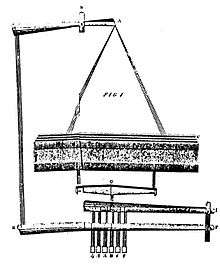John Duncan (weaver)
John Duncan (fl. 1800–1818) was a Scottish weaver who wrote an authoritative book about weaving in 1808.
Biography
John Duncan came from Glasgow, but nothing has so far been found about his ancestry. He was the inventor of a patent tambouring machine[1][2] (Patent No 2769, of 1804). This was an early sewing machine,[3] for "raising flowers, figures and other ornaments on muslins, lawns, silks, woollens, or mixed cloths".[4] Duncan may have used the chain stitch, which was employed for tambour lace, as was later done by Barthélemy Thimonnier.[5] Sometimes Duncan's invention has been described as the first embroidering machine;[6] as with other pioneering machines of the period, it was unsuccessful.[7]

Works
Duncan's major work was Practical and Descriptive Essays on the Art of Weaving (Glasgow, 1808). It was later said, by Clinton G. Gilroy, to be an unacknowledged source used in Andrew Ure's Philosophy of Manufactures.[8]
Duncan wrote an account of his tambouring machine in the Edinburgh Encyclopædia, article "Chain Work," [9] according to Harte. (p. 124)
Duncan was also the probable author of the “Cloth Manufacture” article in Volume 6 of the Edinburgh Encyclopedia, signed “(J.D.)” The entry contains “a description of a loom invented by the author of this article,” which purports to improve upon the vertical loom of Mr. Johnson, also discussed in the entry. Figures 3 and 4 of Plate CXCV, entitled “Vibrating Loom,” illustrate his invention. [10]
Duncan also wrote articles for Rees's Cyclopædia on:
- Draught and Cording of Looms (Vol 12, 1809)
- Draw Loom (Vol 12, 1809)
- Hundreds (Vol 18, 1811)
- Weaving (Vol 38, 1818)
and is possibly the author of:
- Flax (Vol 14, 1810)
- Silk (Vol 32, 1815/16)
- Stocking Frame (Vol 34 1816)
and perhaps the short articles on:
- Diaper (Vol 11, 1808)
- Dimity (Vol 11, 1808)
- Dornock (Vol 12, 1809).
References
- ↑ John Watkins; Frederic Shoberl; William Upcott (1816). A Biographical Dictionary of the Living Authors of Great Britain and Ireland: comprising literary memoirs and anecdotes of their lives, and a chronological register of their publications, with the number of editions printed; including notices of some foreign writers whose works have been occasionally published in England. Printed for H. Colburn. p. 102. Retrieved 1 May 2012.
- ↑ David Brewster (1834). Letters on Natural Magic: addressed to Sir Walter Scott. John Murray. pp. 288–9. Retrieved 1 May 2012.
- ↑ E. F. Carter, Dictionary of Inventions & Discoveries (1969), p. 161; archive.org.
- ↑ Quoted in Harte, N. B., "On Rees's Cyclopaedia as a source for the History of the Textile Industries in the early Nineteenth Century", Textile History, Vol 5, 1974 pp 119-127
- ↑ Ross Thomson (1989). The Path to Mechanized Shoe Production in the United States. UNC Press Books. p. 79. ISBN 978-0-8078-1867-1. Retrieved 1 May 2012.
- ↑ Society of Arts (Great Britain) (1863). Journal of the Society of Arts. The Society. p. 358. Retrieved 1 May 2012.
- ↑ John W. Klooster (30 July 2009). Icons of Invention: The Makers of the Modern World from Gutenberg to Gates. ABC-CLIO. p. 173. ISBN 978-0-313-34745-0. Retrieved 1 May 2012.
- ↑ Clinton G. Gilroy,, The Art of Weaving, by hand and by power, with an introductory account of its rise and progress in ancient and modern times (1844), p. 124 note; archive.org.
- ↑ Henry Howe (1856). Memoirs of the most eminent American Mechanics: also, lives of distinguished European mechanics; together with a collection of anecdotes, descriptions, &c. &c., relating to the mechanic arts. J. C. Derby. pp. 456–. Retrieved 1 May 2012.
- ↑ the Edinburgh Encyclopedia, Vol. 6, "Cloth Manufacture," https://books.google.com/books?id=5ddEAQAAMAAJ&dq=John+monteith+Pollockshaws&source=gbs_navlinks_s